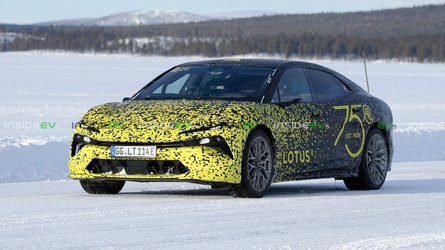Lotus Cars is putting the finishing touches on its all-electric Type 133 sedan, which is expected to be named Envya or Etude. Recently spotted undergoing cold weather testing in northern Scandinavia, the prototype gives us a glimpse of the brand’s upcoming Porsche Taycan rival. The low-slung fastback sedan features several common cues with the Lotus Eletre, including split headlights, a diamond-pattern active lower grille, rearview cameras instead of side mirrors, and pop-out door handles. It also has a roof-mounted LiDAR and massive ventilated brake discs.
Inside, the new Lotus EV is expected to share the seats and steering wheel with the Eletre, as well as other components. It will be a four-seater with a full-length center console, and it will likely offer a full glass roof. As for the powertrain, Lotus can borrow the dual-motor AWD setup from the Eletre R that makes 905 horsepower (675 kilowatts) and 985 Newton-meters (726 pound-feet) of torque. This powertrain can achieve superior performance when paired with a more aerodynamic (and possibly lighter) bodywork.
Lotus will reportedly unveil the Type 133 later this year, with sales expected to follow sometime in 2024. With its sleek shape and powerful powertrain, the Lotus electric sedan is sure to be a hit with performance car enthusiasts.
FAQ
Q1: Are electric car batteries recyclable?
A1: Yes, electric car batteries are recyclable.
Q2: Are electric car chargers free?
A2: It depends on the charger and the location. Some electric car chargers are free, while others may require a fee.
Q3: Can electric car batteries be rebuilt?
A3: Yes, electric car batteries can be rebuilt with the right tools and knowledge.









